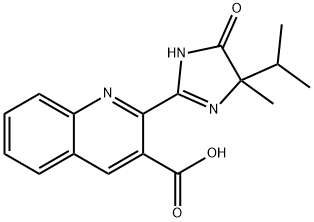Uses
Agricultural chemical.
Definition
ChEBI: 2-[4-methyl-5-oxo-4-(propan-2-yl)-4,5-dihydro-1H-imidazol-2-yl]quinoline-3-carboxylic acid is a quinolinemonocarboxylic acid that is quinoline-3-carboxylic acid which is substituted by a 4-methyl-5-oxo-4-(propan-2-yl)-4,5-dihydro-1H-imidazol-2-yl group at position 2. It is a quinolinemonocarboxylic acid, an imidazolone and a monocarboxylic acid.
Hazard
Moderately toxic by ingestion and skin contact. Low toxicity by inhalation.
Pharmacology
Plant Metabolism. The selectivity of imazaquin is due to
differential rates and routes of metabolism in tolerant
crops versus susceptible weeds (3). The primary
metabolite in soybeans is a pyrroloquinoline acetamide
(41, Fig. 18), which is immobile in the plant and is not
an inhibitor of acetolactate synthase. This metabolite is
further broken down to eventually yield a dicarboxylic acid.
Animal Metabolism. Metabolism studies in the rat
showed that they rapidly excreted unchanged imazaquin
in the urine (5). There was no accumulation of imazaquin or any of its derivatives in the liver, kidney, muscle,
fat, or blood. There was no detectable residue in the
liver, kidney, muscle, or fat of lactating goats and
laying hens, which were fed imazaquin for 7 consecutive
days (5).
Metabolism
Imazaquin kills plants by inhibiting acetolactate synthase
(ALS) (I50 = 1 μM), which is the first common
enzyme in the biosynthesis of the branched chain amino
acids, valine, leucine, and isoleucine. Imazaquin is rapidly
absorbed through the roots of plants. Once it enters
the plant, imazaquin rapidly translocates to the growing
points and growth ceases within 1 day after herbicide
application followed by chlorosis and then necrosis of the
growing points. Total plant death will occur within 2 to
3 weeks after treatment.
Toxicity evaluation
Imazaquin has shown no mutagenic or genotoxic activity in
the Ames assay, mammalian cell gene mutation assay, in
vitro chromosome aberration assay, in vitro unscheduled
DNA synthesis (URS) assay, or the in vivo dominant
lethal assay in male rats. This herbicide also has a low potential for
bioaccumulation in fish.


